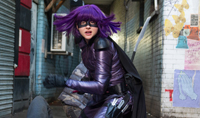
Nvizible VFX and Molinare post joined forces to give ‘Kick-Ass 2’ an exciting cinematic look and develop an efficient, new VFX-to-DI workflow.
A Hero’s Post |
|
Nvizible VFX studio and Molinare post production joined forces on the post for ‘Kick-Ass 2’, giving the movie an exciting cinematic look and developing an efficient, updated visual effects-to-DI workflow designed to help them work together on future productions. The visual effects team at Nvizible in London completed all of the VFX on ‘Kick-Ass 2’, the second movie based on the comic book adventures of high school hero Kick-Ass, bravely fighting crime against all odds alongside the dynamic Hit-Girl. In London toward the end of 2012, Nvizible spent four weeks in pre-production working with director Jeff Wadlow. The team then spent a month on the shoot in Toronto, Canada, and returned in November for further photography and on-set work in London before shot turnover, when their VFX work on the movie’s 350 visual effects shots began in earnest from January to April 2013. |
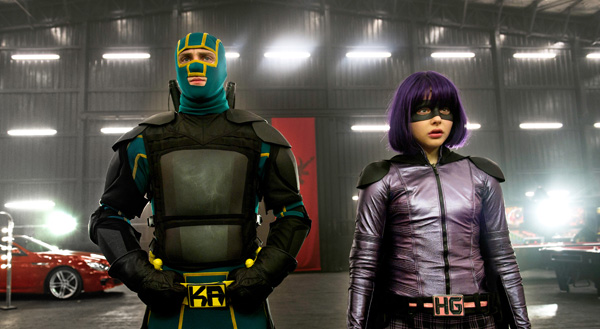 |
Ready to FightThe team’s work focused on the fight scenes of which there were quite a few in this New York story about a group of misfit superheroes fighting a bizarre, ruthless pack of evil criminals, who gather and operate from a concealed hideout known as the Evil Lair. Some of the humour and appeal Kick-Ass and his friends have for his fans come from the fact that these superheroes are definitely not superhuman, nor are their crime fighting techniques anything but down-to-earth. Therefore the effects had to look very realistic, relying mainly on invisible 2D compositing, matte paintings and green screen replacements than on 3D CG, with some interesting exceptions. Because the director Jeff Wadlow needed to keep a limit on the complexity and number of VFX shots, an important part of Nvizible’s work was planning. Balancing effects with live action had to be done with careful design and by capturing enough information from set, the cameras and lenses to make sure the work done in post was realistic, accurate and wouldn’t need extra photography. Nvizible’s VFX Supervisor Hugh Macdonald also helped the director and DP decide how the project could be shot to support the required effects, so that they could stick to plan but still allow for some flexibility once the action came together. Performance Driven“Not much actual previs was created except for the final showdown fight between the heroine Hit-Girl and the evil Mother Russia character,” Hugh said. “After Jeff Wadlow concepted this sequence, previs was created to make the drama work in the space of the set. But the rest of the film relied on detailed storyboarding instead of previs. Jeff wanted the fights and stunt performances, not the visual effects, to lead the show, so all stunts were first choreographed and then the choreography was either supplied to the editor as a guide, or the stunt team would edit the performances themselves. After this, the shots were turned over to us to enhance.” |
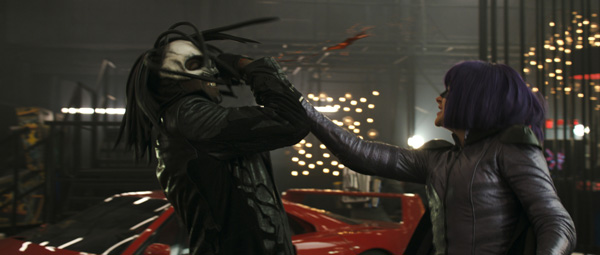 |
|
The fight scenes did, of course, require Nvizible’s work to build excitement and help make them believable, and often to combine performances by the lead actors with those of stunt actors. For example, when Mindy Macready’s daring Hit-Girl stunts place her on top of a speeding van as she is chased through the streets, the live action comprised shots of the lead actress performing within a 360° green screen, cut together with shots of a stunt double performing as she moved along a track. Three background plates shot along that track shoot were stitched together to form the backgrounds, replacing the green screen, aligning the two shoots and pacing the whole sequence according to the story. Into the Evil LairThe climactic Evil Lair sequences, representing some of Nvisible’s major work, were shot in an expansive factory-style warehouse building, allowing the action to be staged in a largely practical set that needed one major enhancement - an intriguing floor-to-roof-top atrium structure that Nvizible built in CG. However, the building the set occupied was demolished shortly after the shoot, which meant the team had to make absolutely sure to record every detail of the structure, dimensions and light while they were on site, including the rooftop. This was the only set survey work the team actually carried out. When the action here moved up to the building’s rooftop - a key story location - for more fighting, the set required a 360° green screen. |
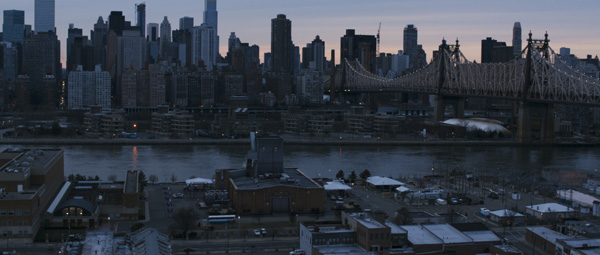 |
|
Because this story takes place neither in Toronto nor London but in New York City, the green screen surrounding the Evil Lair’s rooftop set was replaced with backgrounds developed from plates and images Hugh and his team shot on trips to New York. Four major scenes take place on this set, and they wanted to build it carefully. Hugh travelled to New York on his own in February 2013 to capture rooftop panoramas and building reference. “Then I returned a short time later with a small team in March when the weather was less harsh to shoot aerial views from a helicopter to use for establishing shots, and capture more building reference, general looks and the lighting over the city at different times of the day and night,” he said. “Back in the studio, we studied Google Earth for accurate building layout and the scaling we needed to develop the geography that would be seen from the roof.” CG AtriumThe rooftop sequences unfold over the course of an entire night, from twilight after sunset to sunrise the next morning. While shooting in New York, Hugh and his team shot panoramas using a pan-tilt head camera on a standard tripod, plus HDR images with a Nodal Ninja head, to cover views at each of the four corners of the set, at four to five different times of day. This meant that wherever the camera was looking during any moment in any of the sequences, they had images with both the coverage and the lighting for their matte paintings. The atrium in the Evil Lair was the team’s main CG work in the film, developed as an asset from concept art from the production design team. Hugh explained, “Its design needed to fit both with the factory-style building below and the rooftop set, especially for the final fight when the actors tumble through it. In those slow motion shots, the environment surrounding the actors, and the long view down, is completely CG, making continuity and tying together the looks from set-to-set important so as not to disrupt the action and drama.” |
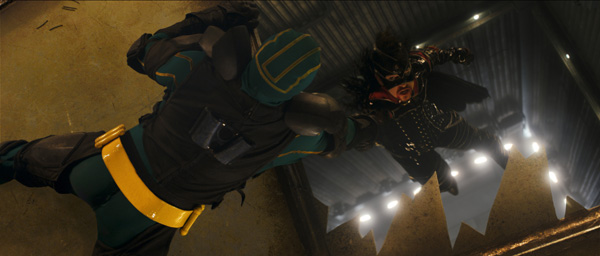 |
|
Hit-Girl’s final showdown at the Evil Lair with Mother Russia is her triumph, when Nvizible’s work was needed not only for realism but for drama. Because their battle finally forces Hit-Girl to kill her enemy with shards of glass, they needed to create CG blades and take body scans for 3D proxy models of both characters to place the blades and blood elements accurately. Furthermore, as she tricks Mother Russia into injecting her with a syringe of adrenaline, giving her an advantage of surprise and the strength to win, the looks and speed of the scene change to reflect Mindy’s heightened reality – the shots include close-ups, the focus shifts, and the action slows down. Action PackedThe Nvizible team’s work can be found at other action moments in the movie. An oddball fight scene takes place on a suburban street where the gang of criminals tries to attack one of Kick-Ass’ superhero friends. As the police arrive, the gang blows up one of the police cars with a homemade bomb. “This explosion was huge and, amazingly, entirely real,” marvelled Hugh. “But because we had to add a stunt double element and shift the car closer to camera, two plates were used within the sequence – one with a smaller explosion and another with the larger explosion – to give us more flexibility in the composite.” Further matte paintings were required at various points as set extensions, including the opening sequence as we watch Mindy coaching Dave to help toughen up his Kick-Ass persona. This was shot at a suburban vacant lot that needed photography of the New York skyline, off in the distance, added to the composite to locate the story. Also, whenever the large warehouse doors at the Evil Lair are flung open, the view onto the street outside had to replace the view. |
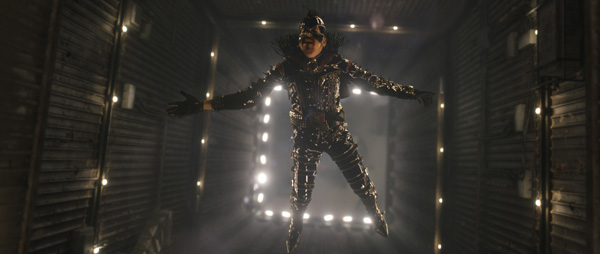 |
|
The fights all needed enhancement with 2D blood elements from Nvizible’s large library plus CG weapons such as knives, blades and others. Because of the range of techniques required for this film - 2D compositing, matte paintings, CG modelling and texturing, green screen replacements and so on - the pipeline had to include a lot of options. Modelling was done using Maya and Mudbox, and texturing with MARI and Photoshop. The animation was done in Maya and also the lighting, with a combination of PRMan, MentalRay and VRay for rendering. All compositing was done in Nuke. “3D tracking for the CG used PFTrack, but we used Nuke for some of the tracking, such as the panoramas going into backgrounds,” Hugh said. “Our surveys of the Evil Lair and the rooftop sets were extensive and gave us enough information to accurately match geometry to the set. Beyond this, we had LED tracking installed in the pillars of the Evil Lair, and the green-screen around the rooftop set had tracking markers that were positioned depending on the shot framing.” DI & Grade at MolinareThe digital intermediate on the film was completed at Molinare post production facility also in London. The DP Tim Maurice-Jones shot this project on the ARRI Alexa Plus and Studio, capturing ARRIRAW to the Codex recorder. Shooting with spherical lenses, he used the Alexa Studio camera 2880x1620 sensor to produce a 2:39 image, while the editorial team working at Pinewood Studios used DaVinci Resolve to create 2K DPX files for grading. A conformed sequence was then sent to Molinare where the footage was graded on a Baselight Eight grading system in their grading theatre. |
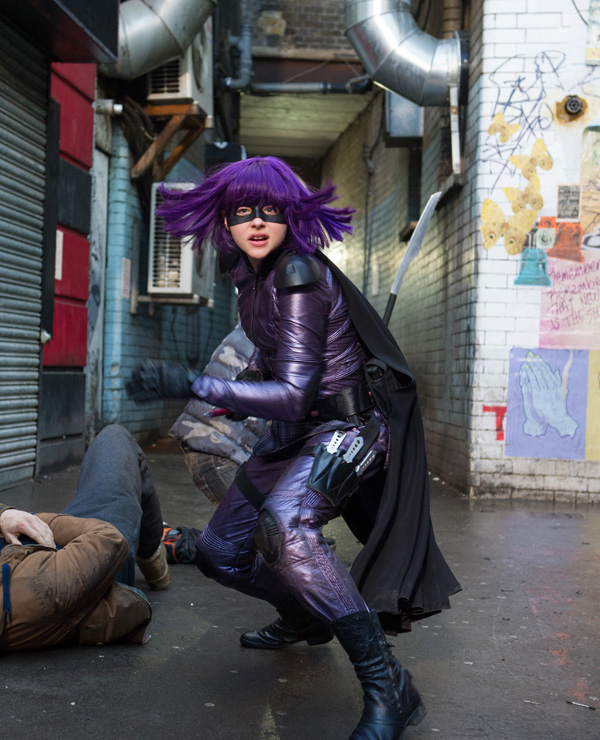 |
|
Editor on ‘Kick-Ass 2’, Eddie Hamilton, continued to edit the film during the three week grade, for which Molinare’s colourist Asa Shoul developed looks on the sequences. Asa’s aim was to produce a rich glossy appearance on the screen, and he often used up to eight layers on a shot. Raw plates were pulled from Nvizible, which they supplied as 2K DPX back to Molinare with mattes, so that foreground and background elements could be manipulated separately. Meanwhile, they tried some new approaches and ways of improving the workflow between VFX and the DI that they expect will save time in the future. Asa explained the processes involved in post production and the grade. “The footage had been shot and used to produce 2.39 images by cropping, allowing the image to be vertically panned for action. We projected at 2038x858, standard 2.39, but because we could view the entire image if required, the cropping didn’t impact on our work at all,” he said. De-Bayering Artefacts“All footage was converted from ARRIRAW to DPX by the editor, using free DaVinci software. This is the first project we have worked on where the editorial used this technique. One of the issues with the pipeline was the fact that the DaVinci de-Bayer did not have any user settings to adjust the artefacts that can appear in super-saturated, bright colours, mostly pinks and yellows, where one of the colour channels would be black. Most de-Bayers attempt to put some value in the ‘missing’ colour channel, which can result in digital blocking and noise. |
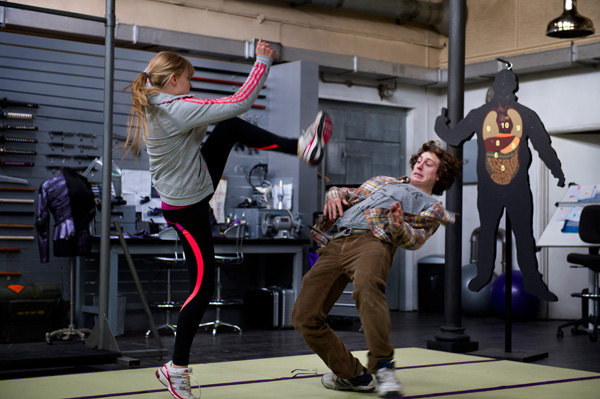 |
|
“The Baselight de-Bayer was re-written last year, after my request. It now includes a colour crosstalk fader which eradicates the artefact in most cases. Consequently, when we saw the artefact in some of the night street scenes in ‘Kick-Ass 2’, in neon signs for example, we requested the shot be sent to us as native RAW that we could de-Bayered through Baselight.” Another issue was that occasionally the DaVinci would skip a frame, which was hard to spot unless the camera was moving, so Molinare had to do extra checks for first and last shot of every shot with a wipe to compare the DPX and the offline. “Also, the shots supplied to VFX were first returned to editorial before they were sent to us at Molinare as part of a sequence,” Asa said. “This added a sharpening artefact at the edges of the frame. These were not visible on normal viewing, only when zooming in to see edges of the frame.” Building the LUTsBefore working with the ALEXA Log C colour space footage on the Baselight Eight, Asa used a primary layer and a second contrast layer in the Baselight to create a more filmic curve. They graded through a Truelight LUT set to Kodak Vision Deluxe which they had built comparing the digital image and print in a split screen setup in the theatre. “We used a separate Truelight LUT for HD deliverables set to Kodak Vision Deluxe Rec709 which, again, we had built comparing the projected image and an OLED Sony professional grade monitor,” Asa explained. “A separate grade pass was done for the HD deliverable, taking a day, and we then rendered in a Truelight Kodak Vision Deluxe DCI-RGB - to - XYZ LUT for the Digital Cinema Package deliverable. |
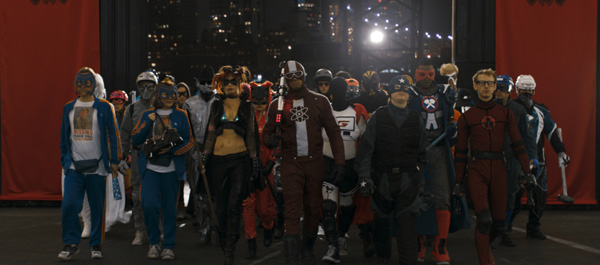 |
|
The DP and director were present for almost the entire two week grade with the editor Eddie Hamilton in the theatre behind them where he set up the Avid on his laptop so that he could show Jeff Wadlow various cuts of scenes. Asa had wanted to be involved at the pre-production stage to talk about the look and design of the film, as he had when he graded the first ‘Kick-Ass’ movie. “The director on that project, Matthew Vaughan, originally wanted a very real, almost documentary look but ended up asking for a more graphic novel, ‘Dick Tracy’ look, which was quite hard to create,” he said. Multiple Shape Layers“On Kick-Ass 2, I visited the set and spoke to the DP, director and editor about looks for the film. Tim Maurice-Jones, the DP, wanted to create different looks for each scene with references ranging from ‘The Omen’, ‘Enemy of the State’, ‘Transformers’ and ‘Carrie’, so Eddie created some quick looks in the Avid. Then in the studio, I used multiple shape layers in the Baselight to focus the viewer on the characters. We would darken walls, skies, floors and so on, and lift the eye details. This was vital as most of the characters wear masks and we had to see every look and glance. I keyed the highlights, blurred the key, then lifted exposure in this range to add a glossy look to skin and hair. Describing the workflow between Nivizible and Molinare Asa said that, ideally, he would have applied a balance or technical grade to all VFX plates. In the van chase scene in which Hit-Girl is on top of a speeding van, for example, the weather changed from overcast to sunny during the shoot, and the green screen stunt shots were shot in a studio. He said, “When we received the final VFX composites, I had to use the supplied mattes to radically re-grade the foreground and background. In an early test with Nvizible we realised that due to the high contrast grade I was applying, the skies became bleached out, so their team made sure there was plenty of colour left in the sky for me to work on. |
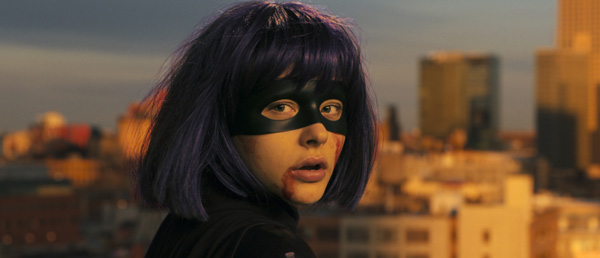 |
Testing the VFX-to-DI Workflow“As I mentioned earlier, most VFX shots first went back to editorial, then from there back to Molinare as 2K DPX with mattes – which is an unorthodox path. Normally we would receive visual effects directly from the VFX house. One of the problems this path caused was that if the editor put a zoom or move on a VFX shot, the matte would no longer match the shot, so we had to be very careful when using mattes that they matched size and position throughout the shot.” Nevertheless, with an eye to collaborating on future projects together, trying new approaches and improving the VFX-to-DI workflow were important aspects of this production. They carried out early testing of their pipeline, for example, and QC of the visual effects and mattes as they arrived. The VFX themselves were tested early to ensure they matched correctly into a scene. “On our next project, I would also like to give guide grades for scenes, as we are doing now on another feature, and provide LUTs for on-set viewing,” Asa said. “These changes would mean less need for VFX to be redone because the artists would already have colour balanced elements and a close to final grade to see.” www.molinare.co.uk www.nvizible.com |
| Words: Adriene Hurst Images: © Universal Pictures International |


















